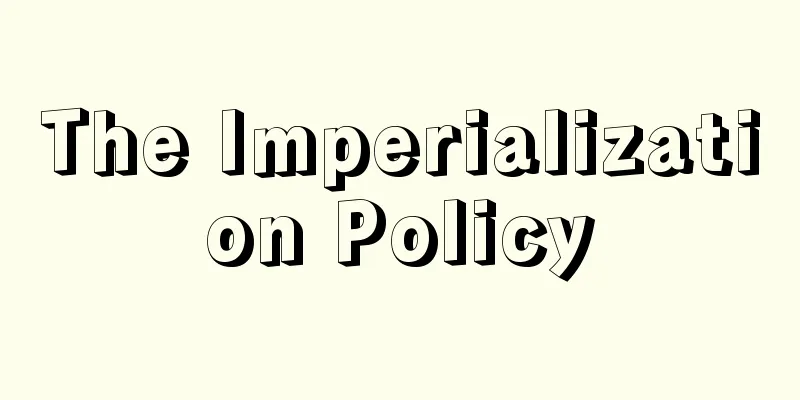New Deal

|
A general term for policies implemented by the F. D. Roosevelt administration in the United States in the 1930s during the economic crisis of the Great Depression. The New Deal means "a new start," and was a term used by Roosevelt to gain public support during his 1932 presidential election campaign, but there was no clear, systematic policy concept at the time. However, to save the American capitalist economy, active measures were taken across almost every sector of the economy, and in the process, the concentration of power in the executive branch, particularly the expansion of the economic functions of the federal government, progressed significantly. As a result, the structure of the American economy underwent important changes, which can be understood by concepts such as state monopoly capitalism, modified capitalism, and mixed economy. [Kenzaburo Shinkawa] ProgressThe policy process from 1933 to the end of the 1930s can be broadly divided into three periods. (1) First Period (1933-34) The government's policy emphasis was on the relief and reconstruction of the economy, which was in a critical situation with over 13 million unemployed and banks being forced to close. Taking the position that domestic reconstruction was a priority, a series of measures were taken, such as the suspension of gold trade with foreign countries, the abolition of the gold standard, and opposition to the Provisional Monetary Stability Agreement at the London World Economic Conference. Meanwhile, the banking crisis was overcome through the declaration of bank holidays and the lending activities of the Reconstruction Finance Corporation, and energetic policies were put forward across many sectors, including relief activities for the unemployed, comprehensive development projects by the TVA, correction of the defects in the stock exchange and banking systems that were one of the causes of the outbreak of the Great Depression, and the Agricultural Adjustment Act, which introduced the concept of equilibrium prices and initiated a production reduction plan. Particularly important and a pillar of the first period was the National Industrial Recovery Act (NIRA), which, in response to capital's demands, allowed "cartelization" in each industrial sector and exempted them from the application of antitrust laws, while also responding to the demands of organized labor, recognizing the right to organize and the right to collective bargaining and establishing minimum working conditions, and establishing the National Recovery Administration (NRA) with broader powers, placing corporate activity under state control. In addition, the Public Works Administration was established, and large-scale public works were carried out under the "Water Incentives" policy to stimulate the economy. (2) Second Period (1935-37) The above policies improved the economy, but the Roosevelt administration was faced with growing public dissatisfaction with the lack of a social security system, increasing labor disputes due to labor clauses, and the ruling of the National Industrial Recovery Act by the conservative Supreme Court, which ruled it unconstitutional. In response, the Roosevelt administration placed greater emphasis on reforms that were said to be a "leftward shift" of the New Deal. Welfare policies were implemented, including the establishment of a social security system, tax reform touted as the "Wealth Tax Act," public works projects by the Employment Promotion Administration that incorporated welfare elements, and the establishment of the Resettlement Administration to address rural poverty. The administration also enacted the Wagner Act, a groundbreaking piece of labor protection legislation. In addition, the NRA-style economic control was abolished, and efforts were made to realize a "managed economy" that would deal with economic fluctuations by manipulating currency, financial, and fiscal policies, while restrictions on monopolies were strengthened, as seen in the Public Utility Holding Company Act. These efforts further strengthened Roosevelt's position as a progressive leader, and he was re-elected in the 1936 presidential election with the support of the "Roosevelt Coalition," which was centered on organized labor, the rapidly growing movement of labor. (3) Third Period (1937-39) Roosevelt's plan to reorganize the Supreme Court led to a stronger trend of unity and rollback among conservatives, and the fruits of his reform policies were limited to the establishment of the Farm Security Administration and the enactment of the Fair Labor Standards Act. Moreover, the economy was hit by a sudden recession in the summer of 1937, and Roosevelt established a committee to investigate monopolies. At the same time, he placed emphasis on strengthening national defense in the face of a worsening international situation, and sought to resolve the situation by significantly increasing government spending, mainly military expenditure. In the process of transitioning to this wartime system, the New Deal's original goal of overcoming the depression was also achieved. [Kenzaburo Shinkawa] Achievements and limitationsThe New Deal was significant in that it attempted to overcome the crisis of the Great Depression by promoting social reform and "democratization." This was especially evident when compared to the fascist countries that were strengthening totalitarian regimes and moving toward foreign aggression. At the time, Roosevelt was considered an internationally progressive leader, and the New Deal was seen as a model of reform policy by democratic forces around the world. Moreover, many of these policies did not remain merely temporary economic measures, but took root in American society and became the basis for subsequent reforms. In addition, during this period, labor unions developed remarkably and the working masses gained more political influence, creating a social foundation that allowed liberals to hold a position as the majority for a long time. However, on the other hand, the failure to achieve a sufficient economic recovery until the transition to a wartime system led to the continued "militarization of the economy" movement even after the war, and the initial negative attitude toward international cooperation also promoted the "formation of blocs" of the world economy, which was problematic. Furthermore, by not addressing the issue of abolishing racial discrimination, this most important issue for the democratization of American society remained pending. It is in these two aspects that we can see both the success and the limitations of the New Deal. [Kenzaburo Shinkawa] "The New Deal" by Kenzaburo Shinkawa (1973, Kondo Publishing)" ▽ "The Economic Policies of the New Deal" edited by the American Economic Research Association (1965, Keio Tsushin)" ▽ "Roosevelt" by W. Luchtenberg, translated by Rikui Saburo (1968, Kinokuniya Bookstore)" ▽ "The Age of Roosevelt" by A.M. Schlesinger, translated and supervised by Nakaya Kenichi, three volumes (1962-63, Ronronsha/1966, Pelican Publishing)" [References] | | |Source: Shogakukan Encyclopedia Nipponica About Encyclopedia Nipponica Information | Legend |
|
大恐慌の経済危機の下で、1930年代にアメリカ合衆国のF・D・ルーズベルト政権により実施された政策の総称。ニューディールは「新規巻き直し」といった意味で、ルーズベルトが32年の大統領選挙運動の際に国民の支持を得るために使ったことばだが、当初明確な体系だった政策構想があったわけではなかった。しかしアメリカの資本主義経済を救済するために、経済のほぼすべての部門にわたって積極的に施策が講じられ、その過程で行政府への権力の集中、とくに連邦政府の経済的機能の拡大が著しい進展をみせ、それに伴ってアメリカの経済構造も、国家独占資本主義、修正資本主義、混合経済といった諸概念で把握されるような重要な変化をきたした。 [新川健三郎] 経過1933年より30年代末に至るその政策過程は、次の三つの時期に大きく区分することができる。 (1)第一期(1933~34) 失業者が1300万人以上に達し、銀行も閉鎖に追い込まれるといった危機的状況に陥っていた経済の救済、復興に政策の力点が置かれた。国内再建優先の立場にたって、外国との金取引の停止、金本位制の廃止、ロンドン世界経済会議での暫定的通貨安定協定に対する反対といった一連の措置が講じられた。一方、銀行休日宣言と復興金融公社の融資活動により銀行危機が克服され、失業者に対する救済活動、TVAの総合開発事業、大恐慌勃発(ぼっぱつ)の一因となった証券取引所や銀行の制度面の欠陥の是正、平衡価格の概念を導入しつつ生産削減計画に着手した農業調整法など、多部門にわたって精力的に政策が打ち出された。とくに重要で第一期の支柱となったのは全国産業復興法(NIRA(ニラ))で、資本側の要求に応じて各産業部門の「カルテル化」を認めて反トラスト法の適用から除外する一方、組織労働者側の要求を入れて団結権と団体交渉権の承認および最低労働条件の規定を設け、さらに広範な権限を有する全国復興局(NRA)を設立、企業活動を国家統制下に置いた。また、公共事業局が設けられ、「誘い水政策」の下に大規模な公共事業で景気の回復が図られた。 (2)第二期(1935~37) 以上の政策により景気は上向いたが、社会保障制度の欠如に対する大衆の不満の増大、労働条項による労働争議の増大、さらには保守的な最高裁判所による全国産業復興法の違憲判決といった事態に直面して、ルーズベルト政権はニューディールの「左傾化」といわれる改革をより重視した政策姿勢を示した。社会保障制度の樹立、「富裕税法」と宣伝された税制改革、福祉的要素を取り入れた雇用促進局の公共事業、農村の貧困問題に取り組む再入植局の設置など福祉政策が手がけられ、また画期的な労働保護立法であるワグナー法の制定をみた。さらにNRA的経済統制をやめて、通貨、金融、財政政策の操作により景気の変動に対処する「管理経済」の実現が図られ、他方公益事業持株会社法にみられるように、独占体に対する規制が強化された。これらにより、ルーズベルトの進歩派指導者としての地歩はいっそう強固になり、1936年の大統領選挙では急速に勢力を増大しつつある組織労働者を中心とした「ルーズベルト連合」の支持を得て再選された。 (3)第三期(1937~39) ルーズベルトの最高裁判所改組計画を契機に、保守派の結束、巻き返し傾向が強まり、改革政策の成果は農場保障局の設置や公正労働基準法の制定などにとどまった。しかも1937年夏に急激な景気後退にみまわれ、ルーズベルトは独占体を調査する委員会を設置する一方、悪化する国際情勢の下に国防力の増強を重視し、軍事支出を中心とした財政支出の大幅な増大により事態の打開を図った。こうした戦時体制への移行の過程で、ニューディール本来の課題である恐慌の克服も達成されるに至った。 [新川健三郎] 成果と限界ニューディールは、大恐慌の危機を社会改革あるいは「民主化」の促進によって乗り切ろうとした点に大きな意義があるといえる。それはとくに全体主義体制の強化と対外的侵略に向かったファシズム諸国と対比した場合、際だっており、当時ルーズベルトは国際的にも進歩的指導者とみなされ、ニューディールは各地の民主勢力から改革政策のモデルとして注目されていた。しかもこれらの政策の多くは、単に一時的な景気対策にとどまることなく、アメリカ社会に定着して、その後の改革の基盤をなすに至った。また、この間に労働組合の目覚ましい発展をはじめ、勤労大衆層の政治的発言力が増大したことにより、以後リベラル派が長期にわたって多数派勢力たる地歩を占めうる社会的基盤ができあがった。だが、他方で戦時体制への移行に至るまで景気の回復を十分に達成できなかったことは、大戦期以後も引き続き「経済の軍事化」の動きを根強いものにさせ、また当初国際協力に否定的態度をとったことも世界経済の「ブロック化」を促進した点で問題があった。さらに、人種差別制度廃止の課題に取り組まなかったため、このアメリカ社会の民主化にとってもっとも重大なことが懸案として残されることになった。これらの両面にニューディールの成果と限界の一端をみいだすことができよう。 [新川健三郎] 『新川健三郎著『ニューディール』(1973・近藤出版社)』▽『アメリカ経済研究会編『ニューディールの経済政策』(1965・慶応通信)』▽『W・ルクテンバーグ著、陸井三郎訳『ローズヴェルト』(1968・紀伊國屋書店)』▽『A・M・シュレジンガー著、中屋健一監訳『ローズヴェルトの時代』全三巻(1962~63・論争社/1966・ぺりかん社)』 [参照項目] | | |出典 小学館 日本大百科全書(ニッポニカ)日本大百科全書(ニッポニカ)について 情報 | 凡例 |
>>: New Town - New Town (English spelling)
Recommend
Kiryumon (English spelling) kui-long-wen
A type of design used on bronze vessels from the S...
Cheering - Kakegoe
〘 noun 〙① A voice used to call out to someone. (i)...
Face - Mentsu (English spelling) mientzu
It is a direct use of the Chinese term, and in Jap...
S. Saheri - S. Saheri
...Mali declined as the Songhai people in the eas...
Meissen porcelain - Meissenjiki (English spelling)
The first hard porcelain in Europe was fired in M...
Parallel processing - heiretsushori (English spelling)
Some parts of a computer program can be run indepe...
Standing tree - Ryuboku
Trees that are still growing on the land, or a gr...
Cannonball (laser)
…The Gekko X11 glass laser installed at Osaka Uni...
Plasma
The components in blood other than blood cells. A...
Revolutionary Socialist Labor Party
…When the party split in 1981, it rebelled agains...
Ishihara Sangyo Co., Ltd.
Before World War II, the company flourished as a m...
Gobenka - Joint petals
A flower with a gamopetalous corolla. The calyx i...
Tetraodontidae
…A general term for marine fishes belonging to th...
richterite
…It is also found in ultramafic rocks such as per...
Mar del Plata (English spelling)
A city on the Atlantic coast located 400 km south-...







![Kashimo [village] - Kashimo](/upload/images/67cb330117c8f.webp)

